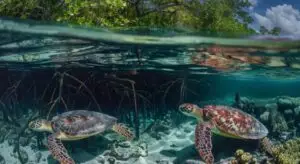by David Freedman Coral Reef Conservation and Biodiversity Awareness | Early Career Ocean Professional (ECOP)
As we look to invest in the ocean while ensuring its sustainability, innovative financial models and strategic shifts in investments are key.
However, proving the efficacy of these strategies often requires real-world examples that showcase tangible results. Here, we explore seven pioneering financial models and investment strategies that are making waves in the global economy, along with real-world case studies demonstrating their impact.
1. Blue Bonds: Financing Marine Conservation and Sustainable Projects
Blue bonds are a type of sustainability bond specifically aimed at financing ocean-related projects that promote marine conservation and sustainable use of ocean resources. Seychelles launched the world’s first sovereign blue bond in 2018, raising $15 million to support sustainable marine and fisheries projects. This bond was partly guaranteed by the World Bank and aimed to transition Seychelles’ fisheries to more sustainable practices, which are crucial for food security and the livelihoods of over 17,000 people. This bond is not only helping to protect over 400,000 square kilometers of ocean but is also enhancing the local economy through better fishery management, which is projected to increase Seychelles’ GDP by 2%.
The positive impact of blue bonds extends beyond conservation. The World Bank estimates that blue economy investments could generate over $3 trillion by 2030 if adopted globally. Countries like Belize and Fiji are following suit, exploring similar financial instruments to manage their ocean resources sustainably. This demonstrates that blue bonds can attract private capital to ocean-friendly projects, proving their viability as a scalable and effective financial tool for sustainable development.
2. Impact Investing: Prioritizing Environmental and Social Returns
Impact investing focuses on generating measurable positive social and environmental impacts alongside financial returns. A notable example is the Meloy Fund, which raised over $20 million to support sustainable coastal fisheries in Indonesia and the Philippines. By investing in small and medium enterprises that engage in sustainable fishing practices, the Meloy Fund has helped protect over 1.2 million hectares of critical marine habitat and improved the livelihoods of more than 100,000 coastal community members. The fund targets an annual return of around 8-10%, showing that sustainable practices can be profitable.
This model appeals to investors seeking both financial returns and the opportunity to contribute to environmental preservation. It illustrates that targeted investments can lead to significant environmental conservation while simultaneously creating economic opportunities for local communities. The success of the Meloy Fund has inspired other impact investors to explore similar opportunities, signaling a shift in how capital is allocated toward the sustainable blue economy.
3. Marine Protected Area (MPA) Insurance: A Safety Net for Ocean Conservation
MPA insurance is an innovative financial tool designed to protect critical marine habitats from climate change and other environmental threats. The Mesoamerican Reef Fund’s MPA insurance program is a pioneering example, providing $1 million in coverage for coral reefs in Mexico and Belize. In the event of hurricanes or other natural disasters, this insurance policy quickly mobilizes funds for reef restoration efforts, ensuring that damaged areas can be rapidly rehabilitated. The MPA insurance model provides a financial safety net, enabling conservation efforts to continue despite natural calamities.
This approach has proved effective, as seen in 2020 when Hurricane Delta struck the region, triggering a payout that supported the swift restoration of damaged coral reefs. Such insurance models provide a clear economic value by safeguarding the ecosystems that support fisheries and tourism industries worth billions of dollars. By maintaining the health of these critical habitats, MPA insurance helps preserve the biodiversity that underpins local economies and global marine health.
4. Seafood Certifications: Leveraging Market Demand for Sustainable Practices
Seafood certifications, such as those provided by the Marine Stewardship Council (MSC), are crucial for promoting responsible fishing practices. Companies and fisheries that meet MSC standards can command higher prices for their products due to consumer preference for certified sustainable options. For example, the MSC-certified tuna fisheries in the Western Pacific have seen their profits increase by 15-20% due to premium pricing. Globally, MSC-labeled products generated over $10 billion in sales in 2020, highlighting the growing demand for sustainably sourced seafood.
These certifications also provide a market-driven incentive for fisheries to adopt sustainable practices, reducing overfishing and promoting healthier marine ecosystems. By aligning economic incentives with environmental sustainability, certifications ensure that market forces drive the blue economy towards responsible growth, benefiting both ecosystems and economies.
5. Blue Carbon Credits: Monetizing Coastal Ecosystem Conservation
Blue carbon credits are a mechanism to monetize the carbon sequestration capabilities of coastal ecosystems such as mangroves, seagrasses, and salt marshes. The Mikoko Pamoja project in Kenya is a leading example, where communities manage mangrove forests that absorb significant amounts of CO2. In return, they receive payments through the sale of carbon credits. This project has generated over $12,000 annually, funding community projects such as schools and clean water initiatives. The sale of these credits not only provides direct economic benefits to local communities but also contributes to global carbon reduction goals.
The blue carbon credit market is poised for expansion, with estimates suggesting it could be worth billions of dollars if fully integrated into global carbon trading schemes. Such projects underscore the potential for blue carbon credits to provide both environmental and economic benefits, turning coastal conservation into a viable economic activity.
6. Public-Private Partnerships (PPPs): Collaborative Approaches to Ocean Health
PPPs bring together governments, private sector companies, and NGOs to fund and implement ocean conservation initiatives. One example is the Great Barrier Reef Foundation’s partnership with the Australian government and corporate sponsors like Rio Tinto. This collaboration has mobilized over $700 million for reef conservation projects, including water quality improvement and coral restoration. The partnership aims to preserve the reef, which contributes an estimated $6.4 billion annually to Australia’s economy through tourism and other industries.
PPPs offer a scalable model for addressing large-scale ocean challenges, leveraging the expertise and resources of multiple stakeholders. By aligning public and private interests, these partnerships ensure that economic growth does not come at the expense of environmental degradation, demonstrating how collaborative efforts can drive substantial investment in the blue economy.
7. Ocean Debt-for-Nature Swaps: Reducing Debt While Promoting Conservation
Ocean debt-for-nature swaps involve restructuring a country’s debt in exchange for commitments to invest in marine conservation. In 2020, Belize initiated a debt-for-nature swap that reduced its external debt by over $500 million in exchange for committing to protect 30% of its marine area. This initiative not only provides immediate financial relief but also secures long-term investment in ocean conservation, with expected savings and additional conservation funding amounting to more than $180 million over the next two decades.
Debt-for-nature swaps offer a win-win solution, aligning financial relief with environmental commitments. They provide a model for countries with high debt burdens and rich natural resources to protect biodiversity while stabilizing their economies. This innovative approach is gaining traction, demonstrating the potential to scale such swaps globally to drive economic and environmental benefits.
These innovative financial models and investment strategies demonstrate that sustainable ocean management is not only necessary for environmental health but also a viable path to economic prosperity.




